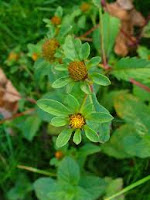LADY’S SMOCK, CUCKOO FLOWERS, CARDAMINE PRATENSIS
 These plants have not had a good press in some parts of the world, and in most of
These plants have not had a good press in some parts of the world, and in most of Europe it would seem that ill-fate will be visited on anyone who picks them. In Germany it was believed that if you picked them your house would be struck by lightning. In France they were thought to be the favourite flower of the adder (a snake) and that if you picked them to include in a May garland, you would be bitten by an adder before the following May Day. In Britain they were not picked or included in May Day garlands because they were considered to be generally unlucky. Lady’s smocks are members of the Brassicaceae or Cruciferae family of plants so are related to the savoy cabbage, red cabbage, broccoli, brussel sprouts, kale, turnips, swede, horseradish, kohlrabi, field penny-cress, mustard and spring greens, so it is no wonder that they were useful antiscorbutics.
Lady’s smocks are members of the Brassicaceae or Cruciferae family of plants so are related to the savoy cabbage, red cabbage, broccoli, brussel sprouts, kale, turnips, swede, horseradish, kohlrabi, field penny-cress, mustard and spring greens, so it is no wonder that they were useful antiscorbutics.  The plant is best used fresh as it loses its potency on drying, and one ounce of herb – leaves and flowers to a cup of boiling water is said to be helpful for skin problems, rheumatism, as a stimulant and diuretic and for the uses Culpeper mentions. You should leave the mixture to steep for 18 minutes and then strain. Add honey to taste.
The plant is best used fresh as it loses its potency on drying, and one ounce of herb – leaves and flowers to a cup of boiling water is said to be helpful for skin problems, rheumatism, as a stimulant and diuretic and for the uses Culpeper mentions. You should leave the mixture to steep for 18 minutes and then strain. Add honey to taste.
These flowers are a welcome sight as they herald the class of the first cuckoo in Britain where they are natives. They are indigenous to Europe , North America and parts of Asia .
They are also called Meadow cress (the leaves and flowers to some extent taste like cress and watercress), May Flower, Pigeon’s Eye and a number of other names- I used to call them Milkmaids, although this is also the name of another British native flower.
Like scurvy-grass, they are rich in vitamin C and minerals and were used against scurvy in the past. The tender young leaves and shoots may be eaten in salads or cooked like spinach and you can add the buds and flowers to your salad too. The leaves and flowers taste very much like cress, although they are perhaps more bitter and pungent.
 These plants have not had a good press in some parts of the world, and in most of
These plants have not had a good press in some parts of the world, and in most of In Ireland it was believed that an animal or person born on May Day had the Evil Eye and to avert it the baby’s eyes had to be washed with the juice of these cuckoo flowers.
They get a mention in Shakespeare’s plays too, as he would have been familiar with them. This is from Love’s Labour’s Lost Act V scene ii:-
“And Lady’s-smocks all silver-white
And cuckoo-buds of yellow hue
Do paint the meadows with delight.”
 Lady’s smocks are members of the Brassicaceae or Cruciferae family of plants so are related to the savoy cabbage, red cabbage, broccoli, brussel sprouts, kale, turnips, swede, horseradish, kohlrabi, field penny-cress, mustard and spring greens, so it is no wonder that they were useful antiscorbutics.
Lady’s smocks are members of the Brassicaceae or Cruciferae family of plants so are related to the savoy cabbage, red cabbage, broccoli, brussel sprouts, kale, turnips, swede, horseradish, kohlrabi, field penny-cress, mustard and spring greens, so it is no wonder that they were useful antiscorbutics. Apart from this use the English herbalist, Nicholas Culpeper, writing in the 17th century, has this to say of their efficacy:-
“Government and virtues. They are under the dominion of the Moon, and very little inferior to Water Cresses in all their operations; they are excellently good for the scurvy, they provoke urine, and break the stone, and excellently warm a cold and weak stomach, restoring lost appetite, and help digestion.”
 The plant is best used fresh as it loses its potency on drying, and one ounce of herb – leaves and flowers to a cup of boiling water is said to be helpful for skin problems, rheumatism, as a stimulant and diuretic and for the uses Culpeper mentions. You should leave the mixture to steep for 18 minutes and then strain. Add honey to taste.
The plant is best used fresh as it loses its potency on drying, and one ounce of herb – leaves and flowers to a cup of boiling water is said to be helpful for skin problems, rheumatism, as a stimulant and diuretic and for the uses Culpeper mentions. You should leave the mixture to steep for 18 minutes and then strain. Add honey to taste.



















